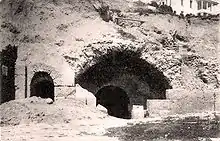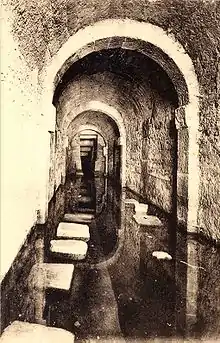Fountain with a thousand amphorae
The Fountain with a thousand amphorae, in French "Fontaine aux mille amphores " is an archaeological site located in the city of Carthage in Tunisia.
 | |
| Location | Carthage, Tunisia |
|---|---|
Discovered in 1919-1920 by Louis Carton, the site is inaccessible to visitors because it is located in the security zone of the Carthage Palace, the official residence of the President of Tunisia. On a spring developed since the time of Ancient Carthage, a fairly complex equipment was made during the Roman era.
History
The Roman construction succeeds a Punic installation according to the discoverer of the site.[1] Indeed, it is there that outcrops the only known spring in the site of Carthage. Prior to the discovery, Alfred Louis Delattre had discovered in the immediate vicinity a pile of 2,000 amphoras, hence the name.[2]
Description

The fountain is not far from the Punic necropolis excavated at the end of the 19th and early 20th century, the necropolis Rabs excavated by Alfred Louis Delattre.
The site constitutes during its discovery one of the main vestiges of the hydraulic installations of the ancient city, with the large cisterns, including the main complex of the cisterns of La Malga.
- Elements[3]
- capture room "partially dug into the rock";[4]
- underground gallery;
- corridor 20 meters long.
References
- Gabriel-Guillaume Lapeyre et Arthur Pellegrin, Carthage punique (814-146 avant J.-C.), éd. Bibliothèque historique, Paris, 1942, p. 38
- Louis Carton, « Découverte d'une fontaine antique », CRAI, vol. 64, n°3, 1920, pp. 258-259
- Colette Picard, Carthage, éd. Les Belles Lettres, Paris, 1951, p. 60
- Louis Carton, op. cit., p. 259